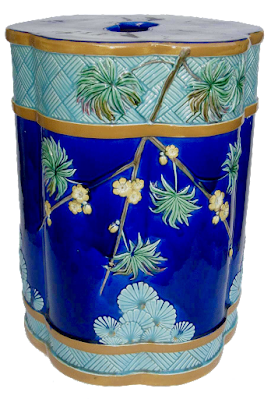Wedgwood majolica Lincoln platter
Wedgwood's Lincoln pattern is certainly the least appreciated and most misunderstood of all of Wedgwood's majolica dessert patterns. In the 1870-80's while Minton and George Jones were finding inspiration in Classicism and the Art Nouveaux treatment of the natural world, Wedgwood embraced the radical new styles of Japanism that developed after the 1861 and 1878 International Exhibitions.
This Anglo-Japanese style was something that industrial designer Christopher Dresser championed during the development of the Aesthetic Movement and helped the style become one of the major influences on ceramic design in the last quarter of the 19th century. Where many smaller potteries utilized the style, Wedgwood was the only one of the three major British majolica manufacturers to develop majolica designs specifically featuring it. Its influence can be seen in Wedgwood's Fan, Palm, Alaska, St. Louis, Grosvenor and Chicago patterns, but it developed full flower in the Lincoln pattern. The Lincoln name, in fact, became the umbrella under which two similar Aesthetic Movement patterns were marketed. These became extremely popular for the company, with over 56 different wares marketed under the Lincoln name.
Wedgwood Lincoln butter dish
There are two similar dessert designs marketed under the Lincoln name that I am aware of. Both have similar decorative components and were designed to compliment the other Wedgwood Anglo-Japanese patterns. They mix very well.
An interesting aside to this is that the Lincoln cheese bell is often found with the Fan base as in the example immediately below. Perhaps this mixing and matching of bases and lids was common, we don't know. The correct Lincoln underplate, shown three photos down, looks very different with a flat profile and chrysanthemum feet.
An interesting aside to this is that the Lincoln cheese bell is often found with the Fan base as in the example immediately below. Perhaps this mixing and matching of bases and lids was common, we don't know. The correct Lincoln underplate, shown three photos down, looks very different with a flat profile and chrysanthemum feet.
Wedgwood majolica Fan cheese bell
Lincoln cheese bell
The main components one finds across these patterns are abstracted blossoming Prunus branches against a simple, non patterned ground. A similar pattern, Alaska, uses the same iconography.
Wedgwood majolica Alaska salad plate
Wedgwood Lincoln salad plate
Wedgwood Lincoln dessert plate
The Lincoln design has the same greek key border seen in the Palm wares. Two feature the stylized chrysanthemums from the St. Louis pattern. Below is a page from the Wedgwood pattern book showing a design for the Lincoln umbrella stand.
Wedgwood pattern book illustration for the
Lincoln umbrella stand
Another one has a wicker ground covering a third of the design with insects resting on top of it; the same wicker also seen in the St. Louis pattern (shown in the oyster plate below).
This bold use of asymmetry was typical of the Aesthetic style.
This bold use of asymmetry was typical of the Aesthetic style.
Wedgwood Palm cheese bell
Wedgwood Argenta Palm cheese bell
Wedgwood Argenta Lincoln plate
Wedgwood Argenta St. Louis oyster plate
Wedgwood Argenta Grosvenor oyster plate
Today these styles strike most of us as odd in their abstraction. It's actually hard to believe they were created over 130 years ago. Where the concept of "more is better" is the common credo behind most Victorian design, these are very modern looking but cool in their austerity and in the simplicity of their geometric lines-- the exact opposite of what most collectors look for in majolica. Perhaps this is why Lincoln pattern wares are not very popular among general majolica collectors. They have never brought high prices. If you put them in context of their times though, they were an extraordinary adventurous step towards the development of modern ceramic design, something for which we should all be aware.
Wedgwood majolica Lincoln jug
Wedgwood majolica Lincoln jug
Wedgwood Lincoln bread plate
Wedgwood majolica Argenta Lincoln platter
Wedgwood majolica Argenta Lincoln condiment



























No comments:
Post a Comment